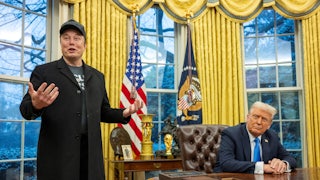The Supreme Court released its 13-page decision in Trump v. Anderson on Monday. In their ruling, which is 9–0 for some parts and 5–4 for others, the justices effectively nullified the Fourteenth Amendment’s disqualification clause for insurrectionists as a meaningful factor in American politics. Congress could theoretically revive the clause by passing a law to enforce it, the majority noted. They know full well that Congress is more likely to declare me the archduke of Nevada.
I already wrote on Monday about the ruling’s manifold flaws: It disregarded the text of the clause itself, it willfully misunderstood how the Fourteenth Amendment works and how American elections are run, and it went further than necessary to decide matters that weren’t before the court. The ruling is also now receiving criticism from a broad cross section of legal scholars and commentators, including some who actually agree with the ultimate result.
Michael C. Dorf, a Cornell University law professor, criticized the court for its mishandling of the Fourteenth Amendment. The court effectively held on Monday that the disqualification clause, which is located in Section 3, is not self-executing. States cannot execute it on their own for federalism reasons, the court concluded, and Congress must pass specific legislation for anyone else to enforce it.
“The Constitution empowers Congress to prescribe how [disqualification] determinations should be made,” the court wrote. “The relevant provision is Section 5, which enables Congress, subject of course to judicial review, to pass ‘appropriate legislation’ to ‘enforce’ the Fourteenth Amendment.”
While that may sound reasonable at first glance, it actually makes no sense if one knows anything about the rest of the Fourteenth Amendment. Section 1 of the amendment, Dorf noted, is very famously self-executing. “No legislation by Congress is required to entitle persons otherwise properly in state or federal court to object that the application of state law or policy to them violates ‘due process’ or ‘equal protection,’” he pointed out. The court’s argument makes even less sense when applied to the disqualification clause, in particular.
“As [the liberal justices] point out, by authorizing Congress to lift the bar on insurrectionists by a 2/3rds vote, Section 3 implies that the default is automatic disqualification,” Dorf explained. “In a passage I read about a dozen times before giving up and assuming that the per curiam author is simply trolling readers, the Court actually says that the assignment to Congress of an ‘amnesty power’ via a 2/3rds vote somehow ‘reinforces’ its (erroneous) conclusion that Section 3 is not self-executing.”
The court’s explanation for this reversal is that the Fourteenth Amendment is ultimately about asserting federal power over the states, and that interpreting the disqualification clause to expand state power over federal officials would “invert” that premise. Dorf noted, however, that the underlying goal of the amendment was to prevent ex-Confederates from seizing power in the South and “for the deeper purpose of preventing the defeated rebels or others who would follow in their footsteps from repeating sins of the past.”
“Seen in that broader perspective, there is nothing at all anomalous about state enforcement of Section 3 against federal office holders or candidates,” he continued. “Where those people are insurrectionists, one might better conclude that failure to enforce Section 3 betrays the 14th Amendment’s core purposes.”
Ilya Somin, a George Mason University law professor, was also critical of the ruling’s reasoning. Part of the court’s logic was that allowing state-level disqualification challenges to succeed would undermine the uniformity of federal elections. But Somin noted that the states routinely play a role in “enforcing and adjudicating other constitutional qualifications for candidates for federal office,” including age requirements and the natural-born citizen clause for president.
“In 2016, there was litigation in multiple states over claims brought by Trump supporters to the effect that Texas Senator Ted Cruz, his chief rival for the GOP presidential nomination, was not a ‘natural born’ citizen,” Somin observed. “State courts in Pennsylvania and New Jersey ruled that Cruz was eligible. But no one doubted that they had the authority to adjudicate the issue.”
He also discounted the court’s fears that upholding the Colorado ruling would lead to “chaos” in state election processes. The justices warned that such chaos more or less compelled their result. “An evolving electoral map could dramatically change the behavior of voters, parties, and states across the country, in different ways and at different times,” the court claimed. “The disruption would be all the more acute—and could nullify the votes of millions and change the election result—if Section 3 enforcement were attempted after the nation has voted. Nothing in the Constitution requires that we endure such chaos—arriving at any time or different times, up to and perhaps beyond the Inauguration.”
It is hard to take this seriously in a conversation about whether a guy who tried to overturn the last election by force should be allowed to run. But even if one agrees with that assessment, it should not inform how one reads the constitutional text. What the court describes as chaos can also be seen as a by-product of the structural features of American democracy.
“Concerns about a potential ‘patchwork’ of conflicting state rulings are ultimately policy objections to the Constitution’s decentralized state-by-state scheme of election administration,” Somin explained. “As the conservative justices (rightly) love to remind us in other contexts, courts are not permitted to second-guess policy determinations that are under the authority of other branches of government or—as in this case—the framers and ratifiers of the Constitution.”
Dan McLaughlin, a lawyer and National Review senior writer, opposed disqualifying Trump outright. “Not one justice thought that Colorado had the power to do what it did in a decision full of elastic reasoning,” he argued on Monday. “Only the most deluded figures of the legal ‘Resistance’ ever believed this gambit would work.” To that end, he thought that the court should overturn the Colorado ruling by holding that Trump’s actions on and around January 6 did not amount to “insurrection” as it is used in the clause.
But while he agreed with the final outcome, he also found plenty of fault with how the court got there. The justices dismissed, for example, the idea that the election clauses in Article 1 and 2, which allow states to hold elections for federal offices, also allow them to apply disqualifications under the Fourteenth Amendment. “Granting the states that authority would invert the Fourteenth Amendment’s rebalancing of federal and state power,” the court wrote.
McLaughlin was unpersuaded. “This is what happens when the court writes too quickly,” he noted. “State courts are bound by the Supremacy Clause, and they are presumptively empowered to enforce the rest of the Thirteenth, Fourteenth, and Fifteenth Amendments (with the arguable exception of Section 2 of the Fourteenth Amendment). Nobody would argue that state courts can’t enforce, say, the equal-protection clause.”
On the policy concerns raised by the court, McLaughlin is also dismissive. “The Court frets that different states could reach different results, possibly due to different state procedures,” he wrote. “But this ignores the role of the Court itself in resolving conflicting state decisions. It is also partly an accidental feature of there being no definitive guidance from the Court on the meaning of Section 3’s operative terms—guidance the Court today yet again declined to provide.” He suggested that the court could have said that Congress could force the states to adopt certain procedural requirements as a backstop, which it can technically still do after Monday’s ruling.
McLaughlin has plenty of criticism for the court’s liberals as well. In their concurrence, he sees a desire by them to ensure that “the charge of ‘insurrection’ can be left a suppurating wound to be reopened at the pleasure of Resistance judges—perhaps waving around the vote of House Democrats.” They, however, were not his ultimate problem with the ruling. “But at the end of the day, in the haste of all the justices to put this pre-election dispute to bed, and in the determination of the liberals to leave open an avenue for post-election guerilla lawfare against a potential second Trump administration, the Court failed in its duty,” he wrote.
The Supreme Court’s failures in Trump v. Anderson are even more striking when you step back and consider the context in which it made them. The American legal system is defined by its use of precedent. In theory, judges make decisions by looking at how their predecessors decided similar cases and applying those principles to the facts before them. Precedent is binding on lower courts and persuasive authority for other courts. It is the glue that binds the whole thing together.
Here the justices had what is now a rare opportunity: They could interpret a provision in the Constitution for the first time. The Supreme Court did not decide any disqualification clause cases during the Reconstruction era, and it has not had a reason to do so since then. The closest thing to precedent that the justices had was a circuit court ruling by then–Chief Justice Samuel Chase acting alone, which is not binding precedent on the full court. For one of the few times in the justices’ careers, they had a blank sheet of paper upon which they could write.
They blew it. The court’s framing of how American elections work and whether the Fourteenth Amendment’s provisions are self-executing are not persuasive even for those inclined to agree with the result. And as The Atlantic’s Adam Serwer noted, the self-described originalist justices did not even use originalist principles to reach their decision. If the justices aren’t going to use their preferred method of constitutional interpretation to interpret a provision for the very first time, with no precedent to constrain them, why should they do it for more well-established ones?
The natural reaction might be to blame the ruling’s faults on the justices’ haste. Some of these problems may have been correctible if the court had had more time to think them through. But that excuse can only take them so far. After all, the justices made it unusually clear at oral arguments last month that they had already made up their minds on the matter. From that premature decision flowed every other mistake they made.










